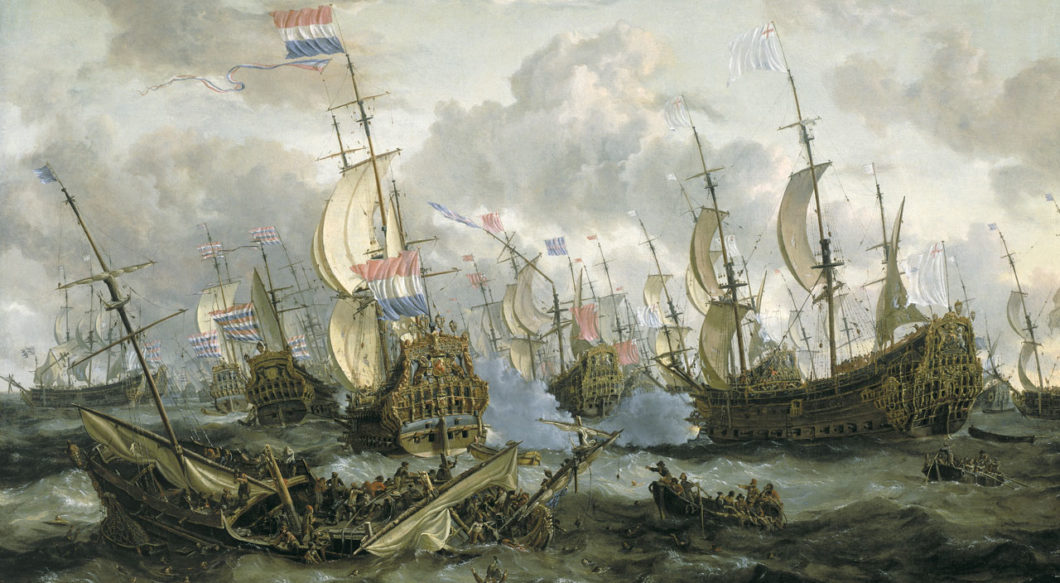Many historians today tell a dismal tale of woe about our Founding, but Wood sees it whole with defects that do not blot out its real virtues.
The World Before Industry
The industrial revolution starting in the 1780s sparked an ongoing cycle of economic growth that transformed global living standards. Describing it as “the most fundamental reordering of human existence since the beginning of agriculture,” Jonathan Scott looks beyond the origins of industrialization in How the Old World Ended to consider what made the way of life it displaced so vulnerable to disruption. The question points to a corner of the North Sea during the 7th century where a commercial revolution with developments in craft production and agriculture preceded the later industrial one. Scott argues that the Netherlands, England and English colonies in America drove a transformation producing “Anglo-Dutch-American early modernity.” Substantively republican in governance and Calvinist or Calvinist tinged Protestant in religion, it prioritized intensively developing resources over passively extracting wealth as Spain did from its empire.
Scott, a New Zealander and Professor at the University of Auckland, treats geography, along with social and intellectual trends, as a critical factor. He grounds modernity in “a world of manufacturing and commerce, stocks, coffee houses, book sellers and news” that generated more dynamism than its rivals. Revolution created that world, particularly the one that overthrew Charles II and brought an English Republic to power in 1649. The Dutch Republic pioneered commercial society, but Scott argues that England consciously followed its model to become an even more successful maritime power aided by settlement colonies abroad. As he formulates it, modernity repudiated established ways that had failed to meet pressing challenges and thereby redefined the Anglo-American idea of liberty. Looking to the sea and the connections it forged gives a new perspective on state building in Early Modern Europe during an age of military revolutions. But how much continuity balanced the changes Scott lauds? Were they the only path to modernity?
Mastering the Seas
Water connects as much as it divides. Like the Mediterranean, the North Sea linked its coastal regions. Merchants of the Hanseatic League reached into the Baltic and along the Atlantic coast during the Middle Ages, while the commercial republics of Venice and Genoa forged links beyond the Mediterranean. Lowland regions centered on the great delta formed by the Scheldt, Maas and Rhine became another center for trade. They marked the northern terminus of a crescent from Barcelona through Northern Italy and Switzerland into the Rhineland that comprised Europe’s most developed regions and overland markets. English ports and the Thames estuary faced the Netherlands across the Narrow Seas.
The Low Countries benefitted from canals and natural inland waterways that provided cheaper transport for bulk goods than roads. Manufacturing, especially cloth, and intensive agriculture generated the wealth sustaining towns. Reclaiming land from the sea also shaped the culture in parts of the Netherlands that were as much a frontier as Europe’s peripheral marchlands or colonies in the new world. Local communities claimed rights and privileges that reinforced the region’s independent spirit.
Scott described the bulk trade in grain as pivotal to overcoming environmental limitations with the North Sea herring fishery providing a product to break the Hanseatic League’s hold on it. Importing grain made up the shortfall in local production to feed the Netherlands while freeing lands for livestock, fodder crops, and market gardening. Manure and nitrogen fixing plants kept farmland in production instead of left fallow to recover soil fertility. These techniques laid the foundation for a later agricultural revolution while fostering urban growth in the Netherlands and craft manufacturing. The trade in grain from the Baltic also bolstered shipping and ancillary businesses. Operating on a larger scale than Venice’s long distance in trade luxury goods, it involved more vessels and drew the Netherlands into other commercial ventures that spanned the globe.
The Dutch struggle for independence from Habsburg Spain drove further changes. Wealth and population concentrated in the Southern Netherlands covering today’s Belgium and French Flanders fled north from its violence. A tradition of local control made provinces jealous of their liberties. Religion sharpened tensions when John Calvin’s teaching gained adherents as the Northern Renaissance’s humanism had turned the emphasis of Christianity from ritual to personal behavior. Open revolt following a violent crackdown in 1567 escalated into a war that devastated the Southern Netherlands. Northern provinces held their own to establish the Dutch Republic with English backing. Refugees who fled there brought skills that fostered economic expansion along with a determination to keep hard-won independence.
The Dutch Republic combined political authority based in cities with localized religious toleration and a rich intellectual life. Its society and politics, Scott argues, were more egalitarian, less aristocratic than Venice and Florence. Calvinism’s rejection of hierarchy in ecclesiastical policy spilled over into secular life. Liberty took on a different meaning shaped by “collective cooperation in a national purpose.” Natural philosophy encouraged a spirit of experimentation that shaped the culture of a highly literate society eager for information. Sir Francis Bacon’s view of science as a tool to master nature and improve upon it set a tone among the Dutch. Antiquity remained a touchstone, but educated classes saw their world as differing from and even outperforming Greece and Rome. Having displaced Portugal in Asia to control the spice trade and withstood Spain, the Dutch Republic dominated global trade by the 1650s. It became an object of emulation, envy, and resentment abroad.
Contrasts in Trajectory
England long had close ties with the Netherlands, and East Anglia’s fenlands resembled them. Scott emphasizes how migration transferred skills to promoted new industries with Flemish and Dutch artisans a significant population segment in London and many towns. Newcomers encouraged by the government brought ideas along with their skills. Proximity that encouraged links also made the Netherlands a bulwark for England’s defense. With the Thames Estuary located opposite the Scheldt, Antwerp was a pistol aimed at the London and environs. Not surprisingly, Elizabeth I and her advisors helped the Dutch against Spain.
Scott also notes important differences. Predominantly rural, the English had not yet developed a maritime ethos. Where the culture of cities shaped many European elites, English gentry and nobles looked to their country estates. Rich farmland—and more of it than the Netherlands had—provided a high living standard on which the English prided their country. Population growth brought tensions but it also created demand that stimulated both economic development and farming innovations borrowed from the Dutch.
London and regions most open to Dutch influences differed from other parts of England during the decades after 1600 where tensions overcame the government’s capacity to manage them. The Reformation had made the realm Protestant, but what kind Protestantism it would follow remained an open question. Calvinism influenced England and drew firm supporters who believed the English Reformation incomplete, but others felt it no less a threat than the brand of militant Roman Catholicism labeled “popery.” Both challenged the authority of the king and landed elites. Rigorous Calvinists saw the Elizabethan Settlement as verging on popery itself. Stuart kings could neither resolve these differences nor quash them by force. Charles I’s failed attempt at the latter in Scotland brought a clash with his English subjects that became a civil war.
Scott argues that its outcome with Charles I’s beheading in 1649 brought the first truly modern revolution. Unlike Germany during the Peasants War in 1525, “a radical Reformation army became the government” with an agenda for moral improvement. London merchants and republicans forged a new trade policy to build a commercial, maritime economy with ancillary sectors required to sustain it. Fiscal reforms with taxation that effectively tapped national wealth paid for a standing army and expanded fleet. Copying Dutch models built England into a formidable rival and sparked a series of Anglo-Dutch Wars.
Oliver Cromwell’s overthrow of the English Republic and Charles II’s restoration in 1660 after his death left many of these changes in place. They matched longstanding efforts to plant English settlements first in Ireland and then North America and the Caribbean. No admirers of the Dutch or their polity, Charles II and his brother embraced the logic of a maritime strategy that put state resources behind commercial expansion and empire. The problem was that they also favored Louis XIV of France and failed to hold the confidence of parliament. Their supporters at the Restoration had imposed Anglican orthodoxy on England rather than the toleration Charles II favored, but Stuart toleration had a pro-Catholic tinge Protestant Englishmen distrusted.
William of Orange resolved the situation in 1688 by overthrowing his father-in-law James II and taking the English throne with his wife Mary II. The resulting Anglo-Dutch partnership brought the British Isles and its overseas domains into the war against Louis XVI’s bid for European hegemony. It also enabled England, later Britain after the 1707 Act of Union with Scotland, to supplant the Dutch Republic as the leading maritime power. Britain secured commercial concessions at the eventual peace, but steps to finance the conflict with king and parliament working together created a fiscal-military state that used borrowing on favorable terms as potent leverage. Parliamentary control over the national debt curbed monarchs, but also gave lenders confidence their money would be repaid. The need to vote taxes servicing loans and the annually renewed Mutiny Act that authorized the army ensured parliament met each year. Becoming a truly parliamentary monarchy gave Britain’s government stronger support than its Stuart predecessors could command.
England’s resources, including agricultural land and population surplus, provided a kind of strategic depth the Netherlands lacked. Domestic surplus production coupled with consumer demand buoyed by higher expectations that buyers had money to satisfy fueled economic expansion that also generated profitable exports. Dutch accomplishments rested on a smaller population operating at close to full employment and without substantial local natural resources like coal or iron. Resources gave Britain over the eighteenth century the means to do more with that spirit of improvement. The agricultural and industrial revolutions followed from that advantage.
Scott also highlights the advantage colonies provided. While the Dutch with a limited population operating at close to full employment failed to exploit territories they occupied, Britain recreated farms and villages in the New World as local conditions allowed. North America, as Benjamin Franklin later observed, encouraged population growth and land ownership. Consumer culture drawn from England made colonies an extension of home markets for goods. Where Kenneth Pomeranz argues in The Great Divergence that Europe outstripped Asia’s economic development partly by exploiting colonial resources, Scott sees the demand for British manufactures as a more important factor sustaining growth in manufacturing to a critical point of take-off. Industrialization was possible because of markets that encompassed overseas colonies to sustain more demand than the British Isles alone.
He also describes the American colonies as an extension of the Anglo-Dutch cultural matrix that forged commercial society. The first New Englanders had been religious exiles in the Netherlands before carrying a strain of militant Calvinism to Massachusetts. Chesapeake and Caribbean colonies also had Dutch ties from trade. New world colonies replicated English patterns and understandings of liberty at their founding shaped by influences from the Netherlands. Besides a consumer ethos, they all shared a commitment to local self-government that clashed with British attempts at imperial reform from the 1760s. Many Americans then looked back to seventeenth century political debates in a king of cultural lag from current metropolitan thinking. Hence the echoes of the Dutch Revolt and English Civil Wars in the American Revolution.
A “Polite and Commercial People”
The maritime culture founded on commerce Scott lauds became the foundation for a different kind of empire from Rome that spanned the globe. But other strains he downplays shaped the synthesis of British culture and institutions over the 18th century. A rural ethos persisted among the nobility and gentry even as they profited from the market. Owning land provided a status that wealth earned from trade or a profession did not confer. Despite later urbanization, England retained a cultural identification with the countryside that romanticism, especially through William Wordsworth, reinforced.
William Blackstone rightly described the English as a “polite and commercial people” in his Commentaries on the Laws of England, but they lived during the eighteenth century in what largely remained in Jonathan Clark’s formulation an Anglican and aristocratic society. Manners followed elite cues and the Church of England enjoyed cultural and political authority with the Radical Reformers ascendant in 1649 marginalized after Charles II’s restoration. Religious Dissent or Nonconformity thereafter defined itself against the Church Establishment rather than setting a tone. Indeed, a trend Scott frames as critical to modernity seemed a throwback a century later. Modern England did not prize enthusiasm.
The modern took forms other than commercial society. Bureaucratic centralization enabled France to overcome challenges generated by war and religious conflict during the crisis of the seventeenth century. Frederick William of Brandenburg, and later Peter the Great of Russia, may have admired Dutch technology and social dynamism, but they adapted them to an absolutist political order. Rulers made developing the realm to strengthen the state by enhancing its resources a priority. State-directed cameralism guided modernization in 18th century Prussia and Austria with a different approach to political economy from the Anglophone world that subsequent liberalization did not erase. Tracing the history behind them, as Scott does admirably here, adds perspective to debate about present-day alternatives.



